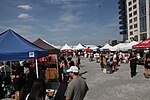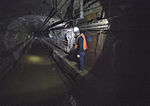Marsha P. Johnson State Park
2007 establishments in New York CityAC with 0 elementsEast RiverLGBT monuments and memorials in the United StatesParks in Brooklyn ... and 4 more
Protected areas established in 2007State parks of New York (state)Use mdy dates from April 2022Williamsburg, Brooklyn

Marsha P. Johnson State Park (formerly and also known as East River State Park) is an 11-acre (4.5 ha) state park in the Williamsburg neighborhood of Brooklyn, New York. The park stretches along the East River near North 7th, 8th, and 9th Streets, with views of the Williamsburg Bridge and Midtown Manhattan. East River State Park opened in 2007 on the site of the Brooklyn Eastern District Terminal. The park was renamed in honor of gay rights activist Marsha P. Johnson in 2020, becoming the first New York state park to be named after an LGBTQ person.
Excerpt from the Wikipedia article Marsha P. Johnson State Park (License: CC BY-SA 3.0, Authors, Images).Marsha P. Johnson State Park
Kent Avenue, New York Brooklyn
Geographical coordinates (GPS) Address Nearby Places Show on map
Geographical coordinates (GPS)
| Latitude | Longitude |
|---|---|
| N 40.721592 ° | E -73.962257 ° |
Address
Smorgasborg
Kent Avenue 90
11249 New York, Brooklyn
New York, United States
Open on Google Maps






